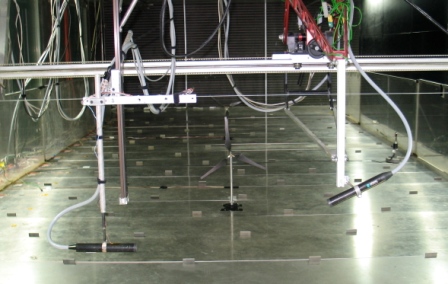Instrument Support Level 3
Dantec FiberFlow
Not Applicable
Calendar

3D Anemometry
The Laser Doppler Anemometer, or LDA, is a widely accepted tool for fluid dynamic investigations in gases and liquids and has been used as such for more than three decades. It is a well-established technique that gives information about flow velocity.
It’s non-intrusive principle and directional sensitivity make it very suitable for applications with reversing flow, chemically reacting or high-temperature media and rotating machinery, where physical sensors are difficult or impossible to use. It requires tracer particles in the flow.
The method’s particular advantages are: non-intrusive measurement, high spatial and temporal resolution, no need for calibration and the ability to measure in reversing flows.
The crossing of two laser beams of the same wavelength produces a ‘fringe’ pattern, areas of constructive (bright) and destructive (dark) interference. Particles in the flow that pass through the fringe pattern, scatter light that is then collected by receiving optics connected to a photomultiplier. The frequency of the scattered light is Doppler shifted by the particle motion and the Doppler frequency is proportional to the component of the particle velocity perpendicular to the plane of the fringe pattern. Where the beams intersect with each other is referred to as the measurement volume.
The Laser Doppler Anemometer used in the EnFlo Tunnel is supplied by Dantec. Further information on the operating principles can be found from their Website.
The LDA system is not regularly calibrated, but Dantec supplied calibrations for both the 27mm probes giving the exact beam separations, which affect the angle that the laser beams intersect in the measuring volume when focused by the lens. Unless the probe is physically damaged this separation distance should not change with time.
Maintaining good data rates on both components is an indication that the probe is probably working ok, because if the position where the beams cross becomes changed, the collection fibre will no longer be focussing in the correct location and the data rate will be affected.
When we use both the 27mm probes simultaneously to measure the same component of velocity eg U, if we bring the measuring volumes close together, we can compare the time traces and statistics and therefore perform an internal check on the data quality.
Field Data
- The instrument produces a range of out files and all are text format.
- The user can download (but not delete) this data from the instrument but it should be noted that this data will not have been quality controlled.
- Data from the LDA system is logged using the EnFlo Software which is our inhouse code written in Labview. The time series for each measurement position is saved in a separate file know as the “Raw data file” and is in binary format. If you want to take away times series of your data, you can post process these “Raw data files” using EnFlo_Software and output the “Time series” for the desired instruments in text tab delimited format. Statistics for each measurement point are stored in “Results files” with names chosen by the user are in text tab delimited format, so can easily be viewed with a spread sheet program such as Excel. If multiple points are specified to log into the same “Results file” each point appends to the existing file growing the number of rows in the spread sheet file. Columns of Metadata appear in the “Results files” so the reference velocities and temperatures etc. are logged with the LDA Velocity statistics. Currently there are around 400 channels of metadata that are added some of which are more applicable than others to any given experiment. The user can use EnFlo Software to create a “Templated files” so just the channels of interest to a given user can be output together with any additional calculations into a text tab delimited file.
Archive Data
- Instrument name is
- Under development
- The data product(s) associated with this instrument:
- Under development
